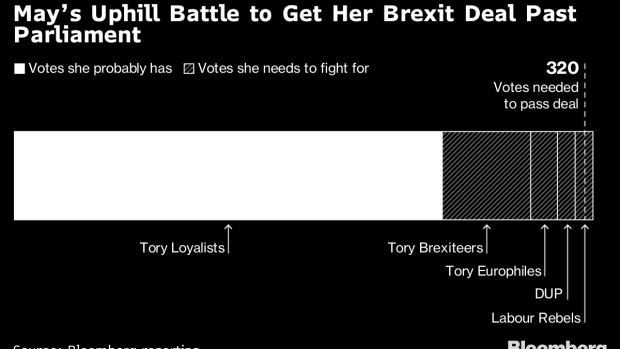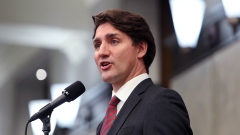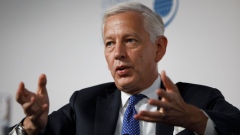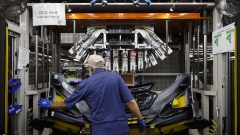Nov 9, 2018
You Do the Math: Can May Get Her Brexit Deal Through Parliament?
, Bloomberg News

(Bloomberg) -- U.K. Prime Minister Theresa May is edging closer to a Brexit deal. But before anyone cracks open the English sparkling wine, she has to get it past Parliament, where she doesn’t have a majority and her Conservative Party is split. So how will she cobble together the votes?
Target: 320
There are 650 members of Parliament in the House of Commons, known as MPs. Of these, the Speaker and his three deputies don’t vote. The seven members of Sinn Fein don’t take their seats. That leaves 639 MPs, so if everyone votes, 320 are needed for a majority.
Voting With May
- Conservative Payroll Vote: around 150
These are the 95 Conservative MPs who have some kind of paid government job, and then around 50 more who work unpaid as a ministerial assistant. They would have to resign from this job to vote against her.
- Conservative Loyalists: around 85
These are the MPs who don’t care very much about Brexit, or want to move the national conversation on to other things, or hope to further their careers, or who are just loyal. May should be able to count on them.
That’s 235. May needs another 85. Now things get hard.
Possibly Voting With May
- The DUP: 10
The Northern Irish Democratic Unionist Party agreed to vote with the government on Brexit matters as part of its 2017 “confidence and supply’’ agreement, essentially giving May’s minority government a parliamentary majority on key legislation. But the party takes a hardline Brexit position, so May shouldn’t assume their support is in the bag until the DUP says it is.
- Labour Brexiteers: 0 to 5
These are Labour MPs who believe in Brexit. Five of them have voted with the government, but the story is complicated. One of them, Kate Hoey, is touring the country attacking May’s as a betrayal of the Brexit cause -- so she could still vote against it. Another, Dennis Skinner, can generally be persuaded to vote with Labour if the government might be defeated.
- Anxious Labour: 0 to 20
Labour MPs who represent pro-Brexit districts and who feel the referendum result should be respected, or who fear the impact of uncertainty dragging on and who want the issue resolved. In October, the Tories talked about this as a sizeable number, but on the Labour side there’s a lot of doubt about that. Labour’s internal pressure group, Momentum, has come out against voting for Brexit. That carries the threat that MPs who vote with the government will be prevented from standing as Labour candidates at the next election. On top of that, if Tory Brexiteers are voting against May’s deal, it’s hard to argue that doing so means you don’t support Brexit in principle.
Probably Voting Against May
- Tory europhiles: between 0 and 12
Whatever their private views, few Conservatives are willing to say publicly that they think Brexit is a mistake. But some have gone as far as voting against the government with a view to keeping closer ties with the EU. Their vilification at the hands of the pro-Brexit newspapers has hardened their resolve, and a portion of them see voting May’s deal as a necessary step on the road to a second referendum. But these aren’t temperamental rebels, so Tory whips will hope they can persuade them back into line -- or at least to abstain -- with warnings of the dangers of a no-deal Brexit.
- Tory Brexiteers: between 10 and 65
The most important non-party grouping in this debate is the European Research Group, the caucus of Conservatives who want a clean break with the EU. Led by Jacob Rees-Mogg, they have forced the government to back down several times this year. Their membership is secret, but 64 signed a letter in October to the Daily Telegraph. While former Foreign Secretary Boris Johnson wasn’t a signatory to that letter, he can be included in this group since resigning from government and becoming an ardent critic of May’s plan.
May can’t win without a serious squeeze on the ERG. According to one person familiar with her plans, Cabinet Brexiteers like Dominic Raab and Michael Gove will be dispatched to sell the agreement as a “Free Trade Deal.’’ The argument will be that while it’s not perfect, it’s a deal that secures Brexit and offers the possibility of getting further away from the EU once Irish border issues are resolved. “Focus on the big prize,’’ Brexit-supporters will be told. And they’ll be warned that rejecting the deal will open the door to a second referendum.
It’s very hard to judge the voting strength of the ERG because they usually win their battles with the government before a vote is cast. One clue is that 51 Tories have signed up to vote against May’s so-called Chequers blueprint from July, and what’s on offer now is arguably an even greater capitulation in the eyes of some hardliners. There are at least 10 people in this group that it’s impossible to imagine voting with May.
Definitely Voting Against May
- Labour Pro-Europeans: 75
This group have little loyalty to leader Jeremy Corbyn and could be seduced by a deal that mimicked the EU’s single market, but May has made no effort to win them over, and this deal isn’t going to do it.
- Labour Loyalists: 155
Corbyn hasn’t actually said Labour will vote against May’s deal, but the party is clearly getting ready to as it markets itself as “the government in waiting.” Defeating May on such a monumental vote would be a path to power. If she loses, he would make the case that she should step down and call a snap election even if another vote isn’t scheduled until 2022.
- SNP: 35; Lib Dems: 12; Greens: 1
These smaller parties -- Scottish Nationalists and Liberal Democrats -- are determinedly opposed to Brexit. May has no hope of getting any of them on board.
To contact the reporter on this story: Robert Hutton in London at rhutton1@bloomberg.net
To contact the editors responsible for this story: Flavia Krause-Jackson at fjackson@bloomberg.net, ;Emma Ross-Thomas at erossthomas@bloomberg.net, Stuart Biggs
©2018 Bloomberg L.P.







